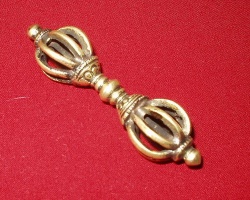Difference between revisions of "Diamond-pounder"
| Line 1: | Line 1: | ||
[[File:Vajra.jpg|thumb|250px|]] | [[File:Vajra.jpg|thumb|250px|]] | ||
| − | |||
| − | |||
| − | |||
| − | + | ||
| − | + | ||
| + | |||
| + | |||
| + | [[diamond-pounder]] | ||
| + | [[金剛杵]] (Skt [[vajra]]; Jpn [[kongo-sho]] ) | ||
| + | |||
| + | |||
| + | Originally a kind of weapon used in {{Wiki|ancient India}}. | ||
| + | |||
| + | It is so called because of its legendary hardness—it was [[thought]] capable of destroying any other weapon, as a [[diamond]] is impervious to all other materials. | ||
| + | |||
| + | In the [[rituals]] of [[Esoteric Buddhism]], the [[diamond-pounder]] [[symbolizes]] the firm resolve to [[attain enlightenment]], which can destroy all [[illusions]]. | ||
| + | |||
| + | This [[diamond-pounder]], or [[vajra]], usually made of {{Wiki|iron}} or {{Wiki|copper}}, is slender in shape with pointed ends. | ||
| + | |||
| + | There are usually three types: a single-armed, a three-pronged, and a five-pronged [[diamond-pounder]]. | ||
| + | |||
| + | Among these, the [[three-pronged pounder]] represents the [[three mysteries]], and the [[five-pronged pounder]], the [[five kinds of wisdom]] possessed by the one [[Buddha]] [[Mahavairochana]] or by [[five Buddhas]], respectively. | ||
| + | |||
{{R}} | {{R}} | ||
[http://www.sgilibrary.org/search_dict.php?SearchSelect=dict&p=3&m=1&in=2&q=Enlightenment www.sgilibrary.org] | [http://www.sgilibrary.org/search_dict.php?SearchSelect=dict&p=3&m=1&in=2&q=Enlightenment www.sgilibrary.org] | ||
[[Category:Buddhist Terms]] | [[Category:Buddhist Terms]] | ||
[[Category:Vajra]] | [[Category:Vajra]] | ||
Latest revision as of 13:56, 7 January 2016
diamond-pounder 金剛杵 (Skt vajra; Jpn kongo-sho )
Originally a kind of weapon used in ancient India.
It is so called because of its legendary hardness—it was thought capable of destroying any other weapon, as a diamond is impervious to all other materials.
In the rituals of Esoteric Buddhism, the diamond-pounder symbolizes the firm resolve to attain enlightenment, which can destroy all illusions.
This diamond-pounder, or vajra, usually made of iron or copper, is slender in shape with pointed ends.
There are usually three types: a single-armed, a three-pronged, and a five-pronged diamond-pounder.
Among these, the three-pronged pounder represents the three mysteries, and the five-pronged pounder, the five kinds of wisdom possessed by the one Buddha Mahavairochana or by five Buddhas, respectively.
